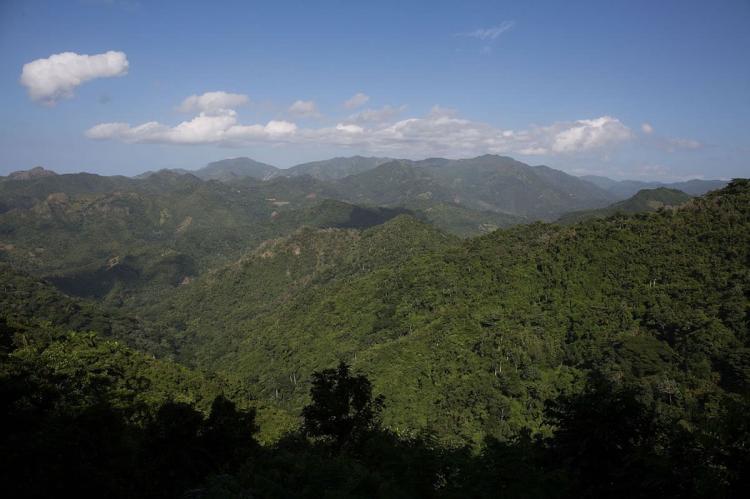Cuchillas del Toa Biosphere Reserve: A Biodiversity Haven in Cuba
Nestled in the northeastern region of Cuba, the Cuchillas del Toa Biosphere Reserve stands as a beacon of biodiversity and ecological significance within the Greater Antilles. Spanning the provinces of Guantánamo and Holguín, this expansive reserve encompasses a diverse range of ecosystems.
Preserving Paradise: The Ecological and Cultural Significance of Cuchillas del Toa Biosphere Reserve
Nestled in the northeastern region of Cuba, the Cuchillas del Toa Biosphere Reserve stands as a beacon of biodiversity and ecological significance within the Greater Antilles. Spanning the provinces of Guantánamo and Holguín, this expansive reserve encompasses a diverse range of ecosystems, from mountainous rainforests to coastal marine areas. Covering 208,305 hectares (514,732 acres), including 6,013 hectares (14,858 acres) of marine area, Cuchillas del Toa is renowned for its rich biodiversity and high levels of endemism.
Geographical Features
Terrain and Climate
The Cuchillas del Toa Biosphere Reserve is characterized by its varied terrain, which includes the mountainous region of Sagua-Garacoa and the iconic Alejandro de Humboldt National Park. The reserve is primarily situated in the watershed of the Toa River, which stretches for 118 kilometers (73 miles) before emptying into the Atlantic Ocean near Baracoa. Notable geographical features within the reserve include El Yunque Table Mountain, the 300-meter (980-foot) waterfall of Infierno Creek, and the Great Cave of Moa, part of a significant karstic system recognized as one of Cuba's natural monuments.
Ecosystems and Climate Zones
Cuchillas del Toa hosts a multitude of ecosystems, each contributing to the reserve's ecological richness. These ecosystems range from rainy mountain and cloud forests to xerophytic matorral (dry scrubland) and complex coastal vegetation, including mangroves and coral reefs. The region's climate varies from the moist conditions of the mountainous interiors to the drier coastal areas, fostering a wide array of habitats that support diverse plant and animal species.
Biodiversity
Flora
The Cuchillas del Toa Biosphere Reserve is a botanical treasure trove, boasting an impressive array of flora with a high degree of endemism. The reserve is home to 928 endemic plant species, including ancient and primitive genera such as Podocarpus and Dracaena. These botanical jewels are part of the reserve's extensive forest ecosystems, crucial in maintaining the region's ecological balance.
Fauna
The fauna of Cuchillas del Toa is equally remarkable, featuring several highly endangered species and some of the world's smallest mammals. Noteworthy vertebrates include the royal carpenter (Campephilus principalis), the caguarero sparrow hawk (Chondrohierax wilsoni), and the almiqui (Solenodon cubanus), a rare insectivorous mammal. The reserve's diverse habitats support a wide range of wildlife, making it a critical area for conservation efforts.
Conservation Efforts
Protected Areas and Management
The Cuchillas del Toa Biosphere Reserve is a protected natural area, with a significant portion of its land designated for conservation. The reserve's core area, Alejandro de Humboldt National Park, is a UNESCO World Heritage Site and one of Cuba's most important protected areas. Conservation efforts focus on preserving the unique ecosystems and endemic species within the reserve, with ongoing research and monitoring programs to understand and mitigate environmental threats.
Challenges and Strategies
Despite its protected status, the Cuchillas del Toa Biosphere Reserve faces several conservation challenges, including deforestation, habitat fragmentation, and the impacts of climate change. Conservation strategies involve a combination of legal protection, sustainable resource management, and community engagement. Efforts to restore degraded areas, control invasive species, and promote sustainable agricultural practices are essential for maintaining the reserve's ecological integrity.
Socio-Economic Impact
Local Communities
Approximately 18,000 people live within the buffer zone and transition area of the Cuchillas del Toa Biosphere Reserve spread across 498 communities. These inhabitants are primarily engaged in traditional agriculture, including coffee, coconut, and cacao cultivation. Ecotourism also plays a significant role in the local economy, providing livelihoods while promoting conservation awareness.
Economic Activities
Local communities are involved in agriculture, ecotourism, forestry and livestock raising. The region's mineral wealth, including nickel, chrome, iron, and cobalt, also supports mining explorations, contributing to the area's economic development. Balancing economic activities with environmental conservation is a key challenge for the sustainable management of the reserve.
Conclusion
The Cuchillas del Toa Biosphere Reserve is a vital ecological and cultural asset for Cuba and the wider Caribbean region. Its rich biodiversity, diverse ecosystems, and unique geographical features make it a priority area for conservation. By protecting this natural haven and promoting sustainable development, Cuba ensures that future generations can continue to benefit from the ecological services and natural beauty of the Cuchillas del Toa Biosphere Reserve. The ongoing efforts to balance conservation with socio-economic development highlight the importance of integrated management approaches in preserving our planet's natural heritage.
